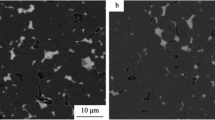Corrosion resistance of hard magnetic Sm2Fe17N3 materials is studied. It is shown that addition of cobalt (up to 8 wt.%) makes it possible to improve corrosion resistance of these materials by 20–25% without reducing their magnetic properties. It is established that additional treatment of Sm2Fe17N3 powder with organosilicon liquid GKZh 136-41 makes it possible to improve corrosion resistance by a factor of 2–3.
Similar content being viewed by others
References
A. M. El-Aziz, A. Barkleit, and M. Herrich, “Corrosion behavior of Nd–Fe–B permanent magnetic alloys,” Proc. 15th Int. Workshop on Rare-Earth Magnets and Their Applications, Dresden, Germany, Aug. 30 – Sept. 3, 1988, pp. 905–913.
J. M. D. Coey, Rare-Earth Iron Permanent Magnets. Clarendon Press, Oxford (1996).
B. B. Damaskin and O. A. Petrii, Electrochemistry, Khimiya, Moscow (2006).
K. Kobayashi, H. Sugiyama, M. Ohmura, and K. Hayakawa, “Coercivity mechanism in the multi-domain Sm2Fe17N3 particles reacted with Zn metal at various temperatures,” Proc. 11th Int. Symp. on Magnetic Anisotropy and Coercivity in Rare-Earth Transition Metal Alloys, Sendai, Japan (2000), pp. 95–104.
C. Kurt, K. O’Donnell, and M. Katter, “Pressure-assisted zinc bonding of microcrystalline Sm2Fe17N x powders,” Appl. Phys. Lett., 60, 3316–3318 (1992).
С. N. Christodoulou, “High intrinsic Coercivity zinc bonded Sm2Fe17N3 Magnets,” Proc. 15th Int. Workshop on Rare-Earth Magnets and Their Applications, L. Schultz and K.-H. Muller (eds.), Dresden, Germany, Aug. 30 – Sept. 3, 1988, Vol. 1, pp. 421–430.
Kume Michiya, Patent 3800589В2 Japan, IPC Н01F 1/053, “Powder magnetic material based on SmFeN and a magnet manufactured from this material,” subm. 03.09.2001, publ. 07.26.2006.
A. M. Belemuk and S. T. Chui, “The coercive behavior and the energy product for multilayers of Fe–Co and Sm–Fe–N,” J. Magnetism Magn. Mater., 324, 3113–3117 (2012).
The article was prepared within the scope of Subsidy Agreement No. 14.578.21.0037 of July 22, 2014 (Unique agreement identifier is RFMEFI57814X0037) between NITU MISiS and the RF Ministry of Education and Science under Federal Targeted program “Research and development for priority areas of developing the Russian scientific and technological complex for 2014–2020” confirmed by Resolution of the Russian Federal Government No. 1096 of November 28, 2013.
Author information
Authors and Affiliations
Corresponding author
Additional information
Translated from Metallurg, No. 11, pp. 74–76, November, 2016.
Rights and permissions
About this article
Cite this article
Tarasov, V.P., Ignatov, A.S. & Kutepov, D.A. Development of Methods to Improve Corrosion Resistance of Hard-Magnetic Sm2Fe17N3 Materials. Metallurgist 60, 1183–1185 (2017). https://doi.org/10.1007/s11015-017-0426-8
Received:
Published:
Issue Date:
DOI: https://doi.org/10.1007/s11015-017-0426-8




